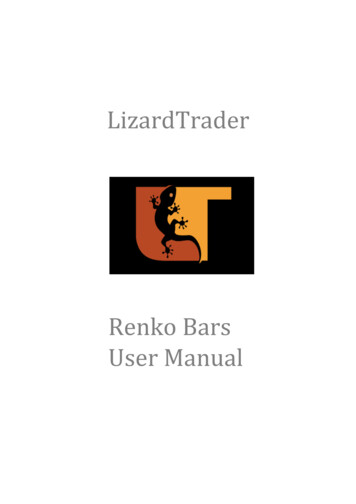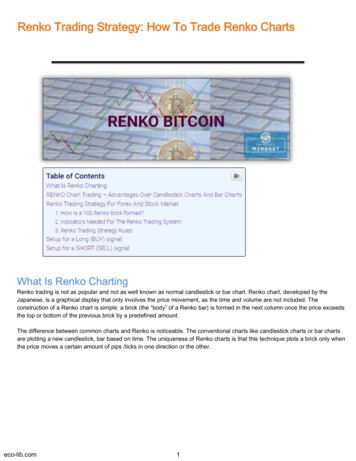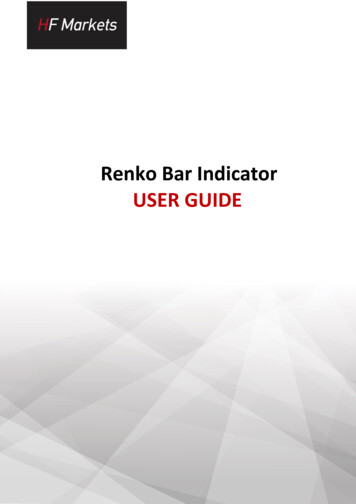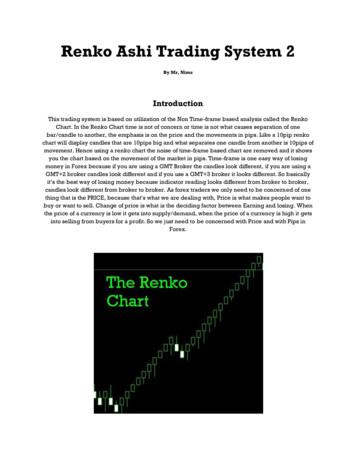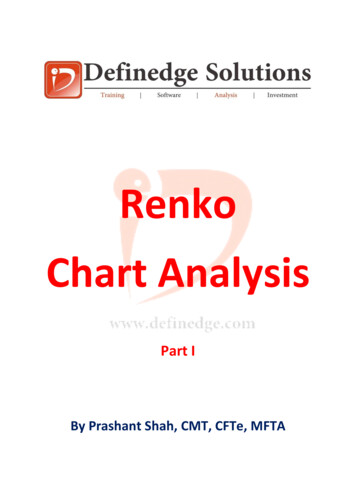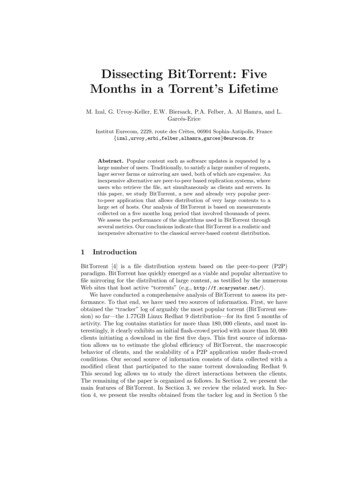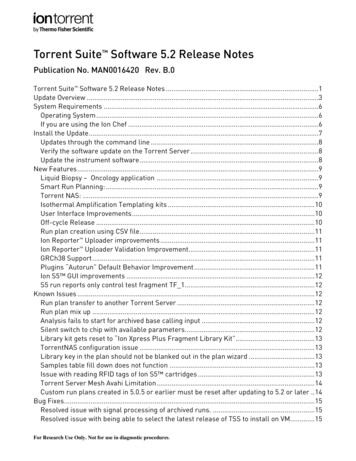
Transcription
Continue
Renko trading system pdf download torrent download fullExtensions to 123 Pattern We have discussed extensions from different swing breakout patterns. Anchor bricks set the tone of a chart. There will be instances where the pattern invalidation level will be some distance away from the stop loss level. Diagonal plotting of bricks gives us an opportunity to plot shadows. It was followed by a bearish twoback at Point C, followed by anchor bricks that set the bearish tone. This bearish pattern fails if a bullish brick is formed above the resistance brick. Point F is a bullish zigzag and polarity principle in the bullish Donchian zone. Brick values vary with time frames; the same brick value cannot be used for both a daily chart and an intraday chart. Istrongly believe this is the best approach for positional traders. Krishnakumar for proof reading and initial editing of the book, and for keeping me in line. The logical interpretation in such a case is that the bulls are creating more bricks than are the bears. And you will be trading with a maximum position size when the trade goes in your favour andproves to be a winner. Figure 3.30 illustrates the rules for trading one-back patterns. In essence, what happens is the first time is the failure of a pattern when the price fails to achieve the extension plotted from the pattern and then invalidates the extension going further. In Renko charts, when a swing breakout fails to last more than two bricks, andif the price reverses back to the breakout level, it is considered a weak breakout pattern (see Figure 4.21). Figure 4.18: Swing engulfing follow through patterns in a 0.50% brick value daily Renko chart of Ashok Leyland You would have noticed that swing engulfing is also a strike back pattern. Fundamental Analysis I am a firm believer in fundamentalanalysis. With Renko charts, we plot a series of bricks which show price swings. When the price forms a bearish swing breakout (A), but fails to record more than two bearish bricks thereafter (B), and instead again turns back above the swing breakout brick (C), it is considered a bullish weak breakout pattern. This occurred after the bullish weakbreakout at Point A and the bullish zigzag at Point B, which makes it more important. Figure 15.4: 40-brick exponential moving average and extensions on a 0.25% brick value daily Renko chart of MCX Gold. Figure 4.52 is a chart showing M and W patterns, and extensions from those patterns. And if the price continues moving in the same direction,one feels remorse at having missed a strong move. Retracement ratio varies from 25% to 66%. Many traders, especially newer ones, attempt to prove that they know better — a mindset which is a road to persistent losses in trading. Note that 105 is also the high price of the previous brick, and we drew the current brick starting from that price. No. 12 3 4 5 6 7 8 9 10 11 12 13 14 Price 99.15 110.20 117.05 110.50 121.85 107.00 124.00 99.90 120.80 124.55 115.20 130.90 141.75 131.65 S. Point E again shows that the distance between the two average lines is reducing though the trend is up. Figure 3.28 illustrates a bearish one-back pattern. The hero of my life, Ravi mama (maternal uncle), is theone I have always looked up to. The rules relating to applying extensions associated with the strike-back pattern are relevant to swing engulfing, too. Figure 1.7: A reversal brick, bearish in this case, would be formed were the price to fall to 105 Based on the above discussion on brick construction, you will readily appreciate that the level where acontinuation, or a reversal, brick will get plotted is known in advance. The same approach can be applied on any brick value, any time frame and any instrument. But if the chart were plotted with the same brick value when the price had dropped to 200, the brick value of 50 would represent 25% of the prevailing price. For me, 123 is a most simpleand effective formation in technical analysis. Figure 2.33: The line chart of Figure 2.32 converted to Renko charts of (1) 0.5% brick value (left), (2) 1% brick value (centre), and (3) 2% brick value (right) I have great trust in breakouts on closing basis in line charts. The breadth indicator counts the number of stocks having bullish bricks; it is expectedto have more stocks with bullish bricks or turning to bullish when the index is bullish. Donchian Channel Donchian channel is an indicator created by Richard Donchian that plots upper and lower bands of price based on the highest high and the lowest low of the last “n” periods. I have presented the concepts the way I understood them with consistentpractice of so many years. I thank him for existing. Patterns B and F are bullish weak breakouts. Figure 4.53: Multi-swing extensions in the 1% brick value daily Renko chart of Infosys The extension at Point A is plotted from an M pattern. It is very easy to discuss it in hindsight, but very difficult to ride a trend through its intervening temporarydrawdowns which hit the paper profits you are sitting on. There are brilliant traders and analysts out there and they can do wonders with Renko charts. Have a look at the Nifty intraday one-minute Renko chart with a 5-point brick value in Figure 14.7 that follows. It is a momentum indicator that calculates the difference between two movingaverages. I asked him about a friend he had been mentoring and he said the other person could not trade the process because he had a target of making profit every month. In essence, this is like an arm-wrestling match between two indices or instruments. Overbought or oversold are extreme zones that indicate exhaustion — but not necessarilyreversal. This ensures that your trades are in sync with the higher order trend. A Quick, Cautionary Tutorial Let’s now consider four charts of the same instrument. We have already discussed entry and exit levels in the case of various patterns, so you know how to plan trades at each price pattern. He traded multiple strategies and his funds wereallocated to different trading systems. Figure 3.34: Bullish one-back pattern formed at 1,100 Extensions from One-Back Like the two-back, the one-back pattern is also a swing breakout and shows the strength of the initial move. It should also always be remembered that what is moving will continue to move. Let us consider Figure 4.23, which is a 1%brick chart of DHFL. Brick Values for Short Term Trading For shorter term positional trading, I would recommend brick values between 0.25% and 1% on daily time frame charts. A brick reversal filters out frequently appearing formations, and other methods of analysis help in identifying high probability trading opportunities. They are used incombination with indicators for trend filtration can be a great setup for intraday charts. The following are the basic tenets of technical analysis according to the classic work, Technical Analysis of Stock Trends by Robert D. Figure 4.22: Bullish weak breakout in the 0.50% brick value daily Renko chart of Amara Raja Batteries Pattern A is bullish weakbreakout pattern. In cricketing analogy, a good batsman should know when to play offence and when to defend. Figure 4.7: Follow through to a bearish strike-back illustrated in this 1% brick value daily Renko chart of NIIT Technology. He was an avid reader. Point H is a new 40-brick low. Figure 3.23: Calculation of extension from two-back patterns.All the methods and analyses discussed in the book are applicable to charts plotted using ATR based brick values as well. The strike prices would have been selected depending on the days remaining until expiry. . — Nison, Steve, Japanese Candlestick Charting Techniques, New York, NY: New York Institute of Finance, 2001. As the number of bricksis higher, the chart gets wider in nature, warranting the use of a higher brick value to address this. Multi-brick breakout is a very important pattern that can be easily spotted in Renko charts. Figure 1.1: Line, bar and candlestick charts Figure 1.2 shows a typical candlestick chart. This is explained in Table 9.1. Table 9.1 Ratio Chart Renko RelativeStrength The ratio chart shown in Table 9.1 can be plotted using the Renko construction method as well. On the other hand, a bearish brick will be plotted if the price drops below the low of the previous brick. Have a look at Figure 7.3. Figure 7.3: Extensions along with 40-brick exponential moving average line on a 1% brick value daily Renko chartof Hindalco All extensions in Figure 7.3 are plotted from bullish one-backs or two-backs above the moving average line — and from bearish one-backs or two-backs below the moving average line. I have also tried to keep the patterns as objective as possible and kept their names simple so that they are easy to remember. Figure 11.12: Extensionanalysis on the 0.25% brick value daily Renko chart of Jet airways Extensions on lower time frames can help a trader identify the short term reference areas. For example, if someone is comfortable with a 5% risk, a Renko formation can be traded with the stop loss of not more than 5 bricks on the 1% brick value chart. Shadows on 0.25%, or lowerbrick values, will be long because they are being plotted only on the last brick of the reversal. Now, let’s have a look at Figure 11.7. Figure 11.7: 40-brick Donchian channel on a 3% brick value daily Renko chart of Shree Renuka Sugars Ltd. I can tell you with all my experience that sticking to strength will not let you get trapped on the wrong side ofthe market. I repeat: you can analyse a situation in as many different time frames as you like but you must stick to a single time frame when it comes to trade execution. I opened an account for a North Indian client settled in Pune. Even if you know a method or system that someone else is successfully trading, you will not be able to replicate the otherperson’s success because you are not him. Attractive visual appearance and the inherent noise filtration characteristics of these charts make identifying and analysing such patterns much simpler and effective on Renko charts. Trade can be identified by using these concepts together. He held that the outcome of each trade was independent and doesnot influence the outcome of the next trade. A bullish two-back formation shows that bears could not hold the correction for more than two bricks, and the bulls then reasserted their dominance. The remaining price action is illustrated in the chart in Figure 1.11. Have a look at Figure 4.30. Table 8.1 Breadth of Every Sector on a Given Day GroupEnergy Index Auto Index-NSE Bank Index Media Index Financial Services Index FMCG Index Service sector Index PSU Bank Index IT Index Metal Index IT Index Commodities Index Consumption Index Realty Index MNC Index PSE Index Pvt Bank Index Pharma Index Breadth Value 60% 56% 50% 93% 55% 66% 56% 5% 50% 73% 50% 60% 70% 30%73% 55% 50% 60% Remark Neutral Neutral Neutral Upside Extreme / Momentum Neutral Neutral Neutral Downside Extreme/ Momentum Neutral Neutral Neutral Neutral Neutral Neutral Neutral Neutral Neutral Neutral Divergences Divergence between breadth and the Nifty index is a time to be cautious. If there is a sharp bounce retracing theentire move, as in the case of swing engulfing, the price is expected to move at least up to the first subsequent wave. The price did not produce any bearish swing breakout post that, and the horizontal formation at Point G indicated that the price retracement upto the earlier uptrend was over and that the price had created the base for a further upmove. Martin Pring, John Murphy, John Bollinger, Kermit Zieg and many other authors are teachers from whom I have learnt chart analysis. He had a very playful approach and was also very open minded. A negative divergence means that the distance between the price and the average has reduced compared to what it was at the previous high. Ifyou find the pattern at a two-back, you can buy with a stop of one box. This is, in fact, the recommended approach. — Schwager, Jack D. We can then check whether a brick on the relative strength chart is bullish or bearish (see Table 9.2). The zigzag price zone often acts as an important reference area on a subsequent revisit by the price. There is abearish one-back at Point 3, when this indicator also suggested that bears were trying to dominate. Or, what you bought might have delivered returns far lower than the ones you missed. This is because weekly time frame charts are not locked till the week is over and the same logic is valid for monthly charts, too. Figure 4.49: Multi-swing extensionBullish multi-swing extensions can be plotted from W patterns, while bearish multi-swing extension can be plotted from M patterns. It will show a positive value when the number of bullish bricks is greater than the number of bearish bricks — and will turn up a negative value when the number of bullish bricks is lesser than number of bearish bricks.Extension of 527.80 is achieved at Point G where the remaining quantities can be sold. This is similar to bar or candlestick charts except that only the last candle changes in that format so it can be easily understood. Pattern G is a bullish zigzag. This way we can see the intraday price move on the Renko chart, as illustrated in Figure 10.2. Figure 10.2:Shadows in a 1% brick value daily Renko chart of DLF In Figure 10.2, it is possible to know the high or the low made during the period. Below is the calculation of the bearish extension: Bearish extension 200 – (8 x 10) 120 If the price fails to achieve the target extension price but, instead, moves above the highest brick of first wave at Point B,the extension then stands negated. Point F is a bearish swing engulfing pattern that did not see a follow through and hence did not get activated. Point L is a weak bearish breakout at the same price level as the bearish zigzag pattern at Point F (refer to the chart in Figure 4.55). When the distance between the shorter term and longer term average isincreasing, and price is in an up trend, it means that the shorter term trend is accelerating faster than the longer term average. We can say that the price is in a bullish zone when it is in between the middle band and the upper band. Plotting extensions on multiple brick values also helps. A Renko double top resistance pattern is confirmed when abearish brick appears after two bullish bricks have formed at a similar level. Simple Renko patterns can be very helpful for intraday trading. One need not wait for the closing to be locked before initiating a trade. While we have discussed many indicators, the basic principle is that it is the Renko patterns that should trigger a trade and not theindicators. He can book profits, or switch to better investments, when there is a change in the price scenario. A bullish swing breakout pattern fails if the price falls one brick below the swing low. Trading in the Zone. One can simply increase the brick value to analyse the larger picture instead of viewing higher time frame charts. The following isthe formula for a bullish extension: Potential Move Number of bricks Brick value Bullish Extension Potential Move Swing high brick price level In the example of Figure 3.10, the number of bricks from Point B to Point C is 8, the brick value is 10, and the swing high price level is 200. Have a look at Figure 2.31. It is important to grasp that thenext bullish brick will be plotted if the price closes either at, or above, 115. Am I comfortable with the rules of this strategy? This book is much better for his contribution. Mean reversion techniques can be effectively used in such scenarios. Prashant is a founder member and CEO of Definedge Solutions (www.definedge.com), a company whichdevelops high quality financial products and research services. Have a look at Figure 3.33. It needs to be confirmed by other observations such as support or resistance, or some other method; for example, the stock or sector has started underperforming, or breadth is showing signs of exhaustion, etc. Mixing the time frames and having no clear exitrules are the trader biggest problems. The pattern will remain valid if the swing high formed by a bearish swing engulfing pattern — or the swing low formed by a bullish swing engulfing pattern — is not breached. Now that you are familiar with Renko patterns, Let’s once again review the earlier Figure 3.4 of BEML and Figure 3.5 of Bajaj Auto chartin the swing breakout section. The same approach is also applicable for short trades based on bearish patterns. Neither the sharp rally displayed in the chart in Figure 17.2, nor the kind of fall highlighted in the chart in Figure 17.3 could have been imagined. Pattern F is a bullish swing breakout that invalidated the bearish extension plotted at PointC. Consider the swing extensions plotted from bullish two-back patterns in Figure 3.24. A combination of simple patterns with a trend identified from indictors is very useful. Patterns F, I and J are bullish two-back patterns. The Renko charts of Grasim shown in Figure 2.13 and Figure 2.14 are very educative. A change in the ATR will lead to a changein the brick value and the chart structure. Money is not made by learning dozens of techniques; it is made by mastering one method. When the price is below the moving average line, we should focus on bearish extensions. At least three bullish bricks that indicate an ongoing bullish uptrend; 2. This was my logic behind creating brick indicatorson Renko charts. Multiple lower shadows occurred at the same level indicating demand at that particular price zone. As discussed earlier, we can see price patterns such as head and shoulders, cup handle, triangles, etc. It will be the brick above the neckline in the case of W patterns, and the brick below the neckline in case of M patterns. Chapter 7Using Indicators on Renko Charts There are numerous indicators that are plotted in bar and candlestick charts. Adding at follow through and continuation formations instead of risking everything at the initial signal is a logical approach, too. Or, to read breakouts based on the high-low prices. Otherwise, we will keep talking and discussing themarkets but won’t be able to trade them successfully. Zigzag is a consolidation breakout pattern. This happens when the price does not make a significant move to warrant plotting of fresh bricks. Figure 1.5: Drawing the second brick as the price rises higher The second brick plotted in Figure 1.5 is also a bullish brick as the new price has closedabove the previous brick’s price level. You can notice support, or resistance, at previous swing lows and swing highs shown on the chart. The upper band shows the highest high over the last 40 bricks and the lower band will show the lowest low over the previous 40 bricks. Figure 3.6: Breakout and failure levels of bullish and bearish swing breakoutpatterns The failure levels highlighted in Figure 3.6 can be used as stop loss when initiating trades. Point G is a bullish one- back pattern. What comes across as a perfect exit for someone may not be relevant to another trader. Table 1.4 summarises the status of the plotting thus far, and Figure 1.10 is the resultant Renko chart. Point G is also abearish zigzag pattern, while Point H is bearish two-back pattern and Point I is bearish one-back pattern which drags the price back into the previous demand zone. Ignore unaffordable signals and wait for patterns with follow-through. Correspondingly, if the most recent brick is bearish, the chart is construed as being bearish. The key is to acceptthat there will be failures while trading any system or pattern. Figure 4.57: 1% brick value daily Renko chart of Tata Steel. Breakouts and patterns based on closing prices are relatively clear and noise free. Figure 3.20: Rules of trading the two-back pattern: One can enter a trade in a bullish two-back pattern at Point 1 placing the stop loss at onebrick below the bearish brick i.e. at Point 2 (see the left hand chart). Traders should remain cautious at such extremes of the breadth indicator and reduce their position sizes during such periods. Point C shows another bullish crossover. Pattern H is a bearish swing breakout post a triangular formation. This was followed by multiple bullish swingbreakouts in the same swing that confirmed the strength in the trend. Maintaining a Trading Journal Apart from writing a trading plan, you must maintain a trading journal to record all your trades. Relative strength can be a great tool for stock picking if you know what to look for. Gaps occurring in favour of one’s trading position will always be mostwelcome. For example, if the price level for exiting the trade is 100, exit the trade if the price goes below that level during the day, but reinstate the position if the price closes above 100 at the end of the day. Figure 10.4: Shadows in a 1% brick value daily Renko chart of Bajaj Finance Figure 10.5: Shadows in a 1% brick value daily Renko chart ofBharat Electronics Ltd. We don’t know whether the price will halt at 23.60% or 38.20%; or if it will get into a deeper correction. He used to trade significant quantities and so he was popular in my branch and we used to look up to him. It can be spotted without much difficultly on Renko charts. The confirmation came from a Renko pattern when ittriggered a bearish one-back, which is marked on the chart (upper panel). Going by the ABCD theory, we can expect a reversal up to Point C of the pattern in Figure 4.29. A strength centric portfolio would deliver better returns over a period. The trend of the instrument was up, and most of the extensions plotted from two-back continuation patternswere met. Remember, though Fibonacci retracements are an integral part of the setup, what we trade with this methodology is the Renko pattern and the trade should be exited if the pattern fails. The extension plotted from Point C is valid so long as the low at Point A is maintained. From the perspective of positional and momentum trading, patternsand extensions on the chart in Figure 6.1 can be useful as entry and exit points. Trading simple Renko continuation patterns in stocks with momentum is one of the best methods I know for short term trading. It is apaprent that the Metal index started outperforming Nifty from February 2016. It is bullish when the latest brick is bullish and bearishwhen latest brick is bearish. J. Weak counters will be beaten hard during corrective phases, making the portfolio bleed and underperform the overall market. For example, if you have some other pattern or indicator for the reversal’s confirmation, you can be a little flexible in such instances. Renko brick reversal formations can help us in seekingconfirmation and trading them. I try to continue her legacy and teach the same values to the apple of my eye, Ahaan, who makes me smile every day. This is a divergence but Renko patterns can help from the practical trading perspective. Price breakout patterns in the leaders can prove more rewarding. Trading the price setups in direction ofextensions is advisable. There can be additional observations on the preceding charts, but I am keeping the discussion to the point. Often, this could be a swing breakout. That way you end up making money when the information you get is correct and you can exit early with minimal loss if the information turns out to be false. The numerator couldcomprise an individual stock, a sector, or any other instrument for that matter. This possibility of changing brick values on the same time frame (data frequency) is a key feature of these charts. The bearish extensions of 801.61 was negated at Point A, where a bullish one-back pattern also got formed. ** Throughout the book, the words “stock” or“instrument” may be understood to mean any financial security, derivative, commodity, currency, etc. This happened in January 2017 around 90 levels. Figure 4.30: Polarity pattern in a 1% brick value daily Renko chart of M&M The price was facing resistance before completing a multi-brick breakout at Point A, which comes across as an invertedhead and shoulders pattern. Figure 4.38 is a chart of Amara Raja Batteries Ltd illustrating a bullish 123 pullback pattern. But you may need different exit methods when a larger universe is being traded and the approach is to pick stocks. Here, again, the achievement or non-achievement of the impulse and corrective extensions from a swing breakouttells us about the strength of the breakout. In Renko charts, swing breakouts can also be traded as a system by themselves. Chapter 11 Selecting the Appropriate Brick Value All trading methods that we have discussed thus far are applicable on all brick values and time frames. Figure 4.13 is a chart of Jubilant Foods showing bullish strike-backpatterns during an uptrend. A strong downtrend is indicated when the MACD line is below the zero line and falling because the distance between the shorter term and the longer term average lines is increasing. Rising breadth is bullish because it indicates that there is participation from more stocks from the group. In this way, I managed to keepin touch with him. Pattern B is a follow through bullish one-back breakout where more quantity can be added. Figure 4.44: Bricks of the 1% brick value daily Renko chart of Century Textile connected by a line You can observe the steady line curves and noiseless data in Figure 4.43 and Figure 4.44. Figure 6.5 is a chart of Ceat Ltd. In trendingmarkets, moving averages act as an excellent tool to identify pullback trade setups. Let your trading record tell you whether “M” is lucky for you or not! Beware of over-tweaking and deliberate at length before adding anything to your plan. Though there is the option to use hourly, or 30-minute, or any other time interval price data, I believeincreasing the brick value on a one-minute time frame is a better strategy because it significantly minimizes the impact cost. In other words, it means that the price is increasing rapidly. From a trading perspective, one can even choose to solely analyse lower brick value charts, such as 0.25% or 0.50%. The follow through rule for trading strike-backscomes with twin advantages. Everything looks good in hindsight and all analysts are great traders — on paper. Figure 3.43 is a 0.50% daily chart of ITC showing bullish zigzag pattern levels. Figure 7.13 is a chart of SRF showing 1, 40, 9 MACD indicator. Figure 1.21: Bullish and bearish brick reversals Now, a logical question that arises is: can onetrade when the brick colour changes? It can be either through a correction or a consolidation. The pattern invalidation level can be different from the stop loss level set while initiating the trade. The simple answer is yes, but, unfortunately, it is difficult to implement this simple sounding strategy in practice. Accordingly, I tried to present setups whichmake Renko charts as objective as possible so that one can understand the logic behind the different formations, remember the associated rules — and trade them effectively. Figure 14.3 is a chart of Bank Nifty with 0.25% brick value plotted with 40EMA and extensions. Chapter 3 Unique Renko Patterns In the previous chapter we discussed how allthe conventional chart patterns are workable and relevant on Renko charts as well. As they say, the most profitable trades occur when you are least comfortable taking them. For indices, I recommend a 1% brick value on the daily time frame for medium term to long term analysis, and 0.25% for short term to intermediate term analysis. All thesequestions might occur in your mind. It is also a swing breakout pattern but it occurs post a price consolidation and that is what adds more information to the simple swing breakout pattern. When and which pattern must be traded can be effectively determined using a trend identification filter such as moving averages. Breakout patterns of Renkoprice chart when the breadth is in neutral zone are very interesting. If not, check the high price of the period to ascertain whether the reversal criteria is fulfilled. Magee. Top Down Approach Sector performance can be compared against the broader market index to assess its relative performance. In a nutshell, this chart analysis suggests a bullishview. Retracement Pullback Zone Fibonacci is a popular theory for retracements. Bullish-Bearish 5 A series of five consecutive bricks can be treated as an anchor brick for intraday trading with 0.25% brick value on one-minute time interval charts (see Figure 13.4). He would give a reasonable time to a strategy even if it delivered returns quickly.Figure 3.36: Bullish one-back pattern extensions in the 1% brick value daily Renko chart of Bharat Finance Figure 3.37 is a chart of BEL showing extensions from one-back and twoback patterns. I am truly thankful to my colleagues at Definedge, Vinay Shah, Nitin Gajbhiye, Abhijit Phatak, Raju Ranjan, B. Stop loss; 2. The trades on Renko charts arehowever considered based on Renko patterns. Figure 2.28: Renko chart of JSW Steel plotted with 5% brick value Figure 2.29: A chart of Jubilant Foods plotted with 5% brick value Figure 2.30 is the daily chart of Reliance Industries with 5% brick value which captures a difficult phase to trade in this stock. I am not a great fan of optimisingparameters. — Bollinger, John. Relative Strength Index (RSI) Developed by J. Instead, they evaluate the market sentiment by measuring the number of stocks in a sector, or a group, that satisfy some given criteria. Every chart looks great in hindsight. I have benefited from many helpful suggestions and comments from Nitin Mude, Rajesh Badiye,Prashant Gupta, Sumeet Jain, Brijesh Bhatia, and K. Most of the decisions taken during such times are short term and emotional. For example, if I am a shortterm trader I would look at the daily time frame chart for trading, and also keep in mind the price action in the weekly or mont
analysis on the 0.25% brick value daily Renko chart of Jet airways Extensions on lower time frames can help a trader identify the short term reference areas. For example, if someone is comfortable with a 5% risk, a Renko formation can be traded with the stop loss of not more than 5 bricks on the 1% brick value chart. Shadows on 0.25%, or lower
